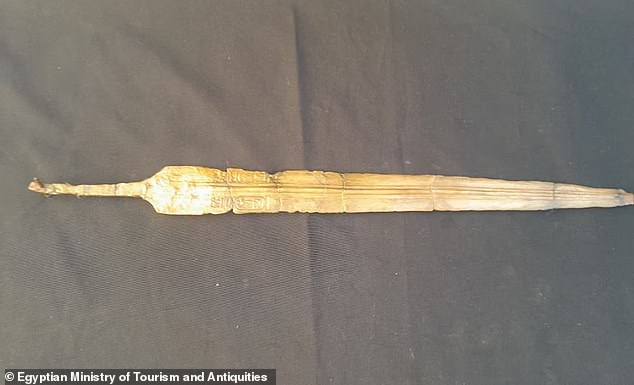3,000-year-old sword with biblical origins discovered in Egypt

Archaeologists have discovered an ancient sword in Egypt linked to a Biblical pharaoh.
The bronze knife, believed to be around 3,000 years old, bears the markings of Ramesses II, who was considered the most powerful king of ancient Egypt.
Many scholars, as well as Hollywood films, have suggested that Ramses was the Pharaoh who enslaved the Israelites in the Book of Exodus
According to the story, Moses freed the group from Pharaoh and then parted the Red Sea, allowing the Israelites into the Promised Land.
The sword was found among the ruins of an old military fort in Housh Eissa, a town just south of Alexandria that contained barracks for soldiers and storage areas for food, weapons and other supplies.

The glittering sword found in Egypt likely belonged to a high-ranking military official during the reign of Ramesses II, who some scholars claim is the pharaoh mentioned in the Bible
Ramesses, who ruled from 1279 to 1213 BC, was known for his military prowess and strategic genius, leading an army of around 100,000 men.
According to experts, the ancient sword probably did not belong to the famous king, but to one of his soldiers stationed in the fortress.
Elizabeth Frood, an Egyptologist at Oxford University who was not involved in the excavations, said The Washington Post: ‘An object with the cartouches of Ramses II would lead me to suspect that it belonged to someone of relatively high rank.
‘Displaying such an object, even if it was probably in a sheath, was a sign of status and prestige.’
The sword was found at a site called Tell Al-Abqain, which experts say was “a crucial military outpost.”
Mohamed Ismail Khaled, secretary general of Egypt’s Supreme Council of Antiquities, said Ahram-online that the fortress ‘protected the northwestern borders of Egypt from possible invasions by Libyan tribes and Sea Peoples.’
The Sea Peoples, a group of aggressive seafarers, were defeated by Ramesses III in 1178 BC when a tribe attempted to invade the country.
Archaeologists from the Egyptian Ministry of Tourism and Antiquities also discovered a treasure trove of ancient wonders, including jewelry, scarabs and protective amulets.
“In addition to the barracks, numerous artifacts and personal belongings of soldiers were also unearthed,” the Ministry of Tourism said.
‘[These] artifacts provide insight into the daily life, religious beliefs and inhabitants of the fort.’
Two limestone blocks were also found, one of which bore the titles of King Ramses II and the other belonging to an official named ‘Bay.’
Ramesses was called the ‘Great Forefather’ by his successors because he led several military expeditions and expanded the Egyptian Empire from Syria in the east to Nubia in the south.
His most famous battle was the Battle of Kadesh, which took place in 1247 BC against the Hittites in present-day Syria.
Ramesses personally led the attack through the Hittite ranks with about 20,000 soldiers.
What made the battle so famous was that it was one of the largest chariot battles in the world and led to the first recorded peace treaty, after the battle ended in a stalemate.
Details of the Battle of Kadesh have been found in ancient stones, but there is also another entry that could contain the story of Ramesses: the Book of Exodus.
The story begins with the Israelites enslaved in Egypt. Pharaoh, who is afflicted with ten terrible plagues, agrees to release them after one of the plagues kills his son. Moses leads them through the miraculously parted Red Sea.

The weapon was discovered among the ruins of an old military fort with barracks and storage areas

The team found other interesting objects at the site, including jewelry, scarabs and protective amulets

Two limestone blocks were also discovered, one of which bore the titles of King Ramses II and the other belonged to an official named ‘Bay’
Although no name is attached to the Pharaoh in the Bible, scholars point to Exodus 1:11 in their argument.
The passage reads: ‘Therefore they set taskmasters over them to oppress them with forced labor, and they built Pithom and Rameses as store cities for Pharaoh.’
Hollywood also promoted this theory in the 1956 film ‘The 10 Commandments’ by naming the pharaoh after the mighty king.
Either way, Ramses has fascinated scientists ever since his body was discovered in 1881 in a secret royal treasury at Deir el-Bahari.
Some experts have used modern technology to bring the king’s face back to life.
In 2022, Sahar Saleem of Cairo University and Caroline Wilkinson of Liverpool John Moores University used a 3D model of his skull and combined it with soft tissue and skin to create his appearance as a ruler of ancient Egypt.
They then reversed the aging process, turning back the clock nearly half a century and revealing what the team said was a ‘very handsome’ ruler.
A more recent facial reconstruction was performed in June of this year, but see what Ramses must have looked like just before his death.

Ramesses, who ruled from 1279 to 1213 BCE, was known for his military prowess and strategic genius, leading an army of some 100,000 men. He ordered the construction of giant statues of himself that stood in Egypt for thousands of years

Ramses II is also said to be the pharaoh mentioned in the Book of Exodus, which tells the story of Moses freeing the Israelites from slavery and leading them to the Promised Land.
Using the same process as the 2022 study, the team created a frail, elderly man with a weathered face.
Cicero Moraes, the Brazilian graphics expert behind the new reconstruction, said: ‘In the present study we carried out a very broad analysis, comparing the reconstructed face with statues of Ramses.
‘The aim was to understand to what extent the images are reliable, since many think that the compatibility would be good. ‘But we saw that this is not the case – the images indicate a good compatibility with the shape of the nose and even, in some situations, with the shape of the face.’
The statues of Ramses II have a finer forehead, finer lips and a more pronounced chin, making the facial features in the image ‘insufficiently reliable’.

In 2022, researchers reconstructed Ramses’ face when he ruled Egypt

A more recent facial reconstruction was performed in June of this year, but look at what Ramses looked like just before his death
“We also analyzed anthropometric and DNA data from ancient Egyptian populations, and all the traces seem to point to a population composed of many elements that are difficult to standardize,” Moraes said.
The team chose a skin tone palette found in ancient Egyptian art, because the actual color is unknown.
The team also used information from a 1976 study of Ramesses’ mummified remains, which were found in 1881, to restore tissues and create new bandages.
The study also revealed that Ramesses II had a noticeable overbite and that his teeth were significantly worn down.
The Pharaoh also had poor dental and bone health, mainly due to an abscess, which must have caused him much pain.
Despite the king’s long life, his muscles showed signs of memory loss and he had very prominent veins on his forehead,’ Moraes and his team said.
The team wanted to express the signs of aging in the reconstruction of the king.
They collected data from hundreds of modern-day Egyptians to determine the likely thickness of the pharaoh’s skin at various points on his skull.
Another technique was anatomical reshaping, in which the face and skull of a living donor – who also had a pronounced overbite – were digitally altered to match the dimensions of the mummy.
The final result interpolated these approaches, before properly aging it and adding subjective elements such as clothing, revealing what Moraes called a “wise” face.




